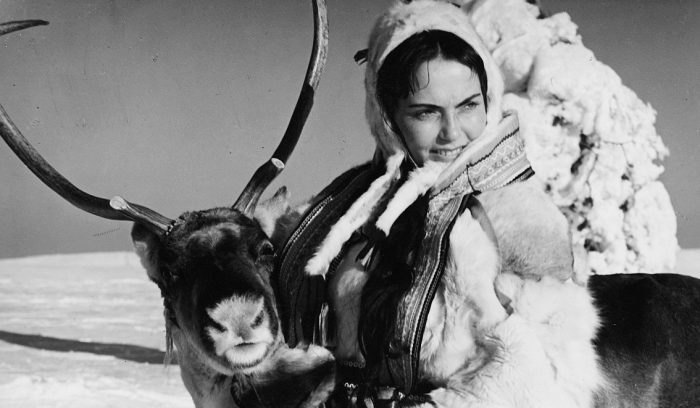
Erik Blomberg was a producer, a cinematographer and editor for years before he ever wrote and directed Valkoinen peura (1953). Blomberg knew the filmmaking craft, backwards and forwards, and was indespensible to the Finnish film industry in his day. So it’s no wonder that his debut feature as a director is the product of a matured stylist. Valkoinen peura (or The White Reindeer in english) is breathtaking in its visual beauty and became an instant favorite of Jean Cocteau. Like Cocteau, Blomberg is interested in blurring the boundaries between “real” and “dream” spaces, changing perspectives from the objective to the subjective.
Blomberg charts these psychological borders via a narrative that draws on an oral mythology, a Finnish folklore, essentially bringing a modern idea of psychology to the fairytale film model. The folklore here is rooted heavily in Sámi theological traditions which itself becomes an allegory for the duality of man; the inner conflict between instinct and intellect. The reckoning with this inner conflict is what motivates the characters who populate Blomberg’s fairytale world, thus exposing the human need for these mythologies as well as articulating the humanity therein.
The barren snow covered plains of Lapland lend the film a visual starkness signifying isolation and human brutality, marking Valkoinen peura as a clear antecedent of František Vláčil’s Marketa Lazarová (1967) and Rainer Sarnet’s November (2017). The barrenness of the landscape becomes the glue for the fantastic elements in these films, allowing these elements to blend plausibly with the more historically realistic aspects of these narratives. The hauntingly beautiful wastelands in these films also help to highlight and exaggerate the human drama of these films. Andre DeToth uses such a landscape in his film Day Of The Outlaw (1959) to give the overriding desperation of every character in the film one shared physical manifestation, which is of course a component of Blomberg’s choice as director and cinematographer.
In Pirita (Mirjami Kuosmanen) Blomberg presents all of the anxieties of marriage manifest in one character that qualifies as any number of types. In the film Pirita discovers her dormant witch powers while visiting a wizard. Soon Pirita finds that not only can she transform into a white reindeer, but that she has lethal vampiric appetites. Pirita begins her story as the ideal house wife and ends it as an indomitable sexual female force who dies at the hands of her husband Aslak (Kalervo Nissilä). It’s a tragic trajectory for the female protagonist that is common in European folklore, serving as a kind of morality tale. Valkoinen peura never treats Pirita as anything but sympathetic which gives the film a quasi-feminist leaning. Pirita’s male counterparts, her victims, are treated by Blomberg as a kind of collective force that opposes the only fully realized female presence in the film.
Valkoinen peura is visual poetry and classical European filmmaking at its finest. Despite the short runtime of just over an hour Valkoinen peura feels epic in scope. Luckily Eureka!’s Masters Of Cinema series has put Valkoinen peura out on home video in an excellent dual format edition. This rare little fairytale film deserves a wider following.
